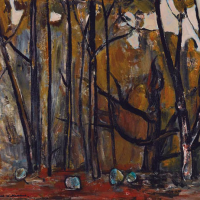47. FRED WILLIAMS

Bayswater Landscape dates from a formative period of Fred Williams career, when the artist returned from five years in London to embark upon a radical reappraisal of the Australian landscape. Hitherto, Williams art had largely concentrated on the human figure his whimsical etchings and drawings of the early to mid-1950s had featured the musicians, actors and circus performers of Londons West End. But from 1957-59, Williams began to realise the potential of the Australian landscape as a modern subject - as a vehicle for formal artistic invention.1 Unlike many of his forebears and counterparts, Williams expressed little interest in the mythical qualities of the Australian bush: the lost explorer on horseback was not for him. Likewise, Williams saw little appeal in naturalism for its own sake. His objective would be that of visual authenticity over mere accuracy.
From 1958 to 1961, Williams would pay regular visits to his friends Nance and Martin Foster, who lived in the Dandenong Ranges east of Melbourne.2 Bayswater Landscape may well have resulted from one of these excursions. The dense eucalypt forests of the Dandenongs readily lent themselves to Williams favoured interpretation of the Australian landscape. As Patrick McCaughey explains, The bush motif was dense, crowded and tactile; it made for solid images and effects and it was spatially close and confined.3 Over the ensuing decade, Williams would return to the Dandenongs to paint at Sherbrooke, Lysterfield and Upwey, creating the works that would cement his reputation as Australias most accomplished landscape painter of the post-war era.
In Bayswater Landscape, Williams reveals a robust frieze of foliage against a milky grey sky. Splayed tree branches radiate upwards, creating a palpable sense of rhythm and movement. The boulders in the foreground are embellished with electric touches of jade green and heavily outlined. Williams landscapes of 1957-59 may be characterised by their ready-made quality: the sense that he found the Australian landscape composed before him, ready for use.4 This is in contrast to his later abstractions of the 1960s, in which the landscape is taken apart and sparingly reconstructed. In nearly all of Williams landscapes, however, there is an absence of linear perspective: the foliage is pressed up against the picture plane to create a compelling sense of immediacy.5
In Bayswater Landscape and other works of this period, Williams sought to resolve a certain tension between drawn design and painterly surface. In order to preserve the structure and readability of his images, Williams instinct for broad and vigorous handling would have to be subjugated to his need to find a clear and correct drawing style.6 The artist fulfils this objective in the present work. Bayswater Landscape shows Williams using a grey-green tonal palette to create formal ambiguities between individual trees and the bush beyond, while simultaneously employing bold outlines and streaks of white paint to delineate trunks and branches. This formal strategy was to underpin his most celebrated works in the years to come.
Footnotes
1. Mollison, J., A Singular Vision: The Art of Fred Williams, Australian National Gallery, Canberra, 1989, p.35
2. Hart, D., 'Resurrecting the Gum Tree', in Fred Williams: Infinite Horizons, National Gallery of Australia, Canberra, 2011, pp.48, 52
3. McCaughey, P., Fred Williams, 1927-1982, Bay Books, Sydney, 1987, p.104
4. Mollison, J., A Singular Vision: The Art of Fred Williams, p.36
5. McCaughey, P., Fred Williams, 1927-1982, p.107
6. Ibid., p.112
Catherine Baxendale, B Phil (Hons), MA (Art Curatorship)